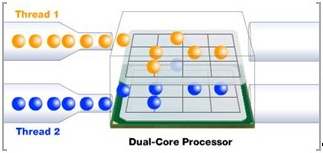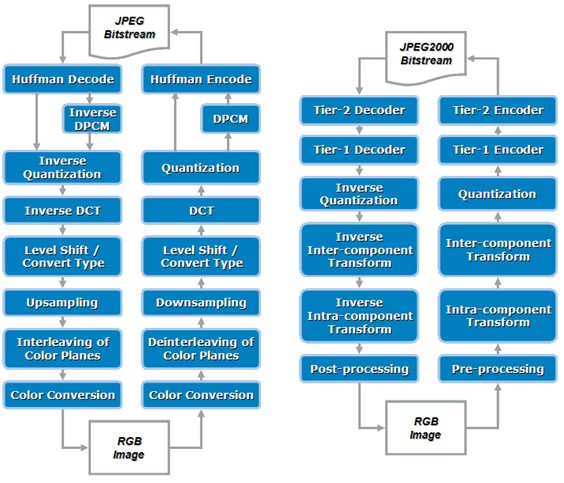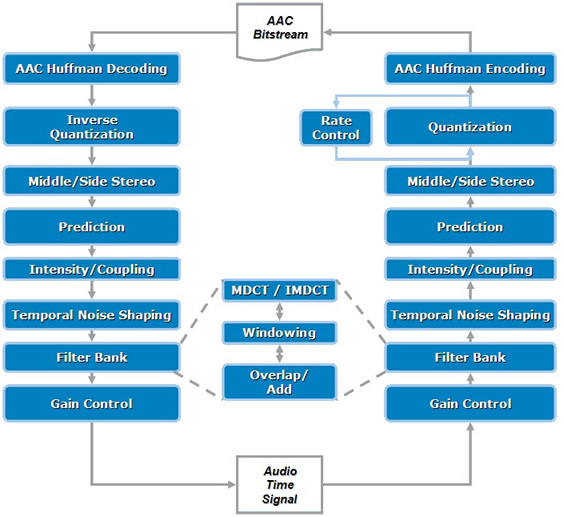for Windows*, Linux*, and Mac OS* X
| Intel® Software Development Products for Intel® Platforms and Technologies | |
| Intel® Integrated Performance Primitives 5.3 for Windows*, Linux*, and Mac OS* X |
|
 |
|||||||||||||||
|
|||||||||||||||
|
| Multi-Core Processor Support | ||||
 |
||||
Figure 1. Multi-Core Processors |
||||
| Multi-Core Processors Enable the True Parallel Execution of Multi-Threaded Software Applications | ||||
| Multi-Core Optimized Functions: Many critical functions for Vector and Statistical mathematics, Signal Filtering, Fourier Transforms, Image/JPEG Compression and Color Conversion are internally threaded using OpenMP* for the highest performance on multi-core systems. | ||||
| Multi-Core Optimized Code Samples: Many of the Intel IPP code samples are threaded to illustrate the effective use of Intel IPP functions in applications such as video encoding and decoding. | ||||
| Fully Thread-Safe Functions: All Intel IPP functions are fully thread-safe, simplifying integration into threaded applications. | ||||
| To learn more about threading and Intel IPP functions visit our Threading Frequently Asked Questions (FAQ) page. | ||||
| back to top
|
|
Intel IPP functions are designed to deliver performance beyond what optimized compilers alone can deliver, by matching the function algorithms to low-level optimizations based on the processor’s available features such as Streaming SIMD Extensions (SSE) and other optimized instructions sets. |
|||
| back to top
|
| Video Coding: Key algorithmic components for DV25/50/100, MPEG-2, MPEG-4, H.263, and MPEG-4 Part 10 (H.264) codecs. Figure 2 shows where Intel IPP video coding components (represented by the blue boxes) fit into the H.264 codec process flow. Functions include: | ||||
| Motion Compensation | ||||
| Motion Estimation | ||||
| Modified Discrete Cosine Transforms | ||||
| Quantization and Inverse Quantization | ||||
| Entropy Coding | ||||
| Figure 2. Intel® Integrated Performance Primitives (Intel® IPP) Components in the H.264 Codec Process Flow |
||||
| The Video and Audio code samples illustrate sample codec implementations using Intel IPP functions. | ||||
| Back to Function Domain List
|
| Image and 2D Signal Processing: Intel IPP is the premier library of image and 2D signal processing algorithms, and includes a rich selection of algorithms operating on images and regions within images (ROIs): | ||||||||||||||||||||||||||||||||||||||||||||||||||||||||||||||||||||||||||||||
|
||||||||||||||||||||||||||||||||||||||||||||||||||||||||||||||||||||||||||||||
| Back to Function Domain List
|
| Computer Vision: Includes optimized functions for many key computer-vision operations, for applications in security, machine control, media management, media annotation and more: | ||||||||||||||||||||||||||||||||||
|
||||||||||||||||||||||||||||||||||
| Back to Function Domain List
|
| Color Conversion:Intel IPP provides a rich set of optimized color-conversion routines on 32/24/16-bit-per-pixel formats: | |||||||||||||||||||||||||
|
|||||||||||||||||||||||||
| Back to Function Domain List
|
| String Processing: Build optimized text database management, search and retrieval, or document indexing processing into your applications using Intel IPP’s optimized string operations. | ||||||||||||||||||
|
||||||||||||||||||
| Back to Function Domain List
|
| JPEG Coding: Key algorithmic components for JPEG, JPEG 2000, and Motion JPEG codecs. Figure 3 shows where Intel IPP JPEG coding components (represented by the blue boxes) fit into the JPEG and JPEG 2000 codec process flow. | |||
 |
|||
| Figure 3. Multi-Core Processors Components in the JPEG And JPEG 2000 Codec Process Flow |
|||
| Back to Function Domain List
|
| Speech Coding: Includes functions for the following: | ||||||||||||||||||||||||||||||||||
|
||||||||||||||||||||||||||||||||||
| Back to Function Domain List
|
| Signal Processing: Includes signal processing features for the following: | ||||||||||||||||||||||||||||||||||||||||||||||||||||||||||||||||||||||
|
||||||||||||||||||||||||||||||||||||||||||||||||||||||||||||||||||||||
| Back to Function Domain List
|
| Data Compression:In addition to video, audio and image compression with codecs, Intel IPP provides functions for lossless compression menthods, such as those used in the popular “zlib” (inflate and deflate) and “libbzip2” libraries: | |||||||||||||||||||||||||
|
|||||||||||||||||||||||||
| Back to Function Domain List
|
| Audio Coding: Key algorithmic components for MP3, AAC, and AC3 codecs. Figure 4 shows where Intel IPP JPEG coding components (represented by the blue boxes) fit into the AAC codec process flow. Functions include: | ||||
| Huffman Coding | ||||
| Motion Estimation | ||||
| Modified Discrete Cosine Transforms | ||||
| Block Filtering | ||||
| Frequency Domain Prediction | ||||
| Spectral Band Replication | ||||
| Fast Fourier Transforms | ||||
 |
||||
| Figure 4. Intel® Integrated Performance Primitives (Intel® IPP) Components in the AAC Codec Process Flow |
||||
| The Video and Audio code samples illustrate sample codec implementations using Intel IPP functions. | ||||
| Back to Function Domain List
|
| Speech Recognition: Build advanced speech recognition, Voice-over-IP, and voice annotation capabilities in applications, using Intel IPP’s broad range of speech-recognition capabilities: | ||||||||||||||||||||||||||||||
|
||||||||||||||||||||||||||||||
| Back to Function Domain List
|
| Vector/Matrix Operations: Contains a rich set of matrix and vector operations fir a wide variety of applications, including physics modeling and 3D transform/lighting calculations: | ||||||||||||||||||||||||||||||||
|
||||||||||||||||||||||||||||||||
| Note: For applications requiring high-performance linear algebra operations on very large data sets, the Intel® Math Kernel Library may also be of interest. | ||||||||||||||||||||||||||||||||
| Back to Function Domain List
|
| Cryptography: Intel IPP to quickly build robust, high-performance cryptographic modules and applications. Below are some of the many cryptographic building blocks included in Intel IPP’s cryptography functions. | ||||||||||||||||||||||||||||||||||||||
|
||||||||||||||||||||||||||||||||||||||
| Intel IPP’s cryptography algorithms have been formally validated under the Cryptographic Algorithm Validation Program (CAVP): | ||||||||||||||||||||||||||||||||||||||
|
||||||||||||||||||||||||||||||||||||||
| Note: To access the Cryptography Library, you must request access from Intel. | ||||||||||||||||||||||||||||||||||||||
| Back to Function Domain List
|
| Ray-Tracing and Rendering: Core operations used in ray-tracing, realistic image rendering, and physics applications: | ||||||||||
|
||||||||||
| Back to Function Domain List
|
|
| Expanded Data Compression Functions and Code Samples | ||||
The Data Compression code samples have been expanded, and now include compression/decompression utilities that are command-line compatible with gzip and bzip2. Scripting applications can use these sample applications to accelerate server-side data management applications, and more. |
||||
In addition, Intel IPP 5.3 now includes full support for Run-Length Encoding (RLE) data compression. |
||||
| Optimized for the 45-nm Intel® Core™ 2 Processor Family | ||||
Intel IPP 5.3 delivers new performance optimizations specially targetted at the 45-nm Intel® Core™2 processor family. The 45-nm Intel Core 2 processor family includes new features such as Intel® Streaming SIMD Extensions 4 (Intel® SSE4), a set of 47 new instructions representing the most significant improvement to the Intel® 64 instruction set architecture since 2001. |
||||
| Optimized for the 45-nm Intel® ultra-mobile processor technologies | ||||
Intel IPP 5.3 also adds new performance optimizations specially targetted at the 45-nm “Silverthorne” ultra-mobile processor. |
||||
| New Operating System Support | ||||
Intel IPP 5.3 expands the range of supporting operating systems, including:
|
||||
| JPEG and JPEG2000 Codec support for Microsoft .NET* | ||||
Intel IPP 5.3 now provides code samples for JPEG and JPEG2000 encoding/.decoding under the Microsoft .NET framework. |
||||
| back to top
|
|
| Operating Systems Intel IPP version 5.3 expands on previous versions, by adding new support Windows* Vista*, and 64-bit Mac OS* X applications. Code re-use and cross-platform operating system development is simplified by having one library API for Windows*, Linux* and Mac OS* X. |
|||||||||
| Development Environments Intel IPP is fully compatible with other development tools from Intel, such as compilers, performance and threading analyzers, and other Intel® Performance Libraries. In addition, Intel IPP is easily used and integrated with popular development tools and environments, such as Microsoft Visual Studio*, Xcode*, Eclipse*, and the GNU Compiler Collection (GCC). |
|||||||||
| Processors | |||||||||
|
|||||||||
| back to top
|
|
| Application Target Platforms | |
| Installation Requirements |
| Application Target Platforms | |||||||||||||||||
| Please refer to the section below that matches your application's target computing platform: | |||||||||||||||||
| 32-bit Intel Architecture Platforms |
|
||||||||||||||||
| 64-bit Intel® 64-based platforms |
|
||||||||||||||||
| 64-bit Intel® Itanium® 2 processor Family Platforms |
|
||||||||||||||||
| Intel® XScale® Microarchitecture-based Platforms |
|
||||||||||||||||
| 32-bit IA-32 Intel® Architecture-Based and Compatible Platforms | ||||||||||||||||||||||||||||
| (Intel® Core™ 2 Processor Family, Intel® Core™ Processor Family, Intel® Pentium® Processors, and compatible AMD* processors) | ||||||||||||||||||||||||||||
| OS Version | Supported Compilers | |||||||||||||||||||||||||||
| Microsoft Windows* |
|
|
||||||||||||||||||||||||||
| Linux* |
|
|
||||||||||||||||||||||||||
| Mac OS* X |
|
|
||||||||||||||||||||||||||
| 64-bit Intel® 64 Architecture-Based and Compatible Platforms | ||||||||||||||||||||||
| (Intel® Core™ 2 Processor Family, Intel® Pentium® D Processors, Intel® Xeon® Processors, and processors from AMD compatible with the Intel 64 architecture) | ||||||||||||||||||||||
| OS Version | Supported Compilers | |||||||||||||||||||||
| Microsoft Windows* |
|
|
||||||||||||||||||||
| Linux* |
|
|
||||||||||||||||||||
| Mac OS* X |
|
|
||||||||||||||||||||
| 64-bit Intel® Itanium® 2 Processor family Platforms | ||||||||||||||||||||
| OS Version | Supported Compilers | |||||||||||||||||||
| Microsoft Windows* |
|
|
||||||||||||||||||
| Linux |
|
|
||||||||||||||||||
| Embedded Applications on Intel XScale® Microarchitecture-based Platforms | ||||||||||
| (Intel® IXP4xx Product Line of Network Processors) | ||||||||||
| OS Version | Supported Compilers | |||||||||
| Microsoft Windows* |
|
|
||||||||
| Linux |
|
|
||||||||
| Installation Requirements | |||||||||||||||||||||||||||||||
| Supported Software / Hardware | |||||||||||||||||||||||||||||||
| Operating Systems |
|
||||||||||||||||||||||||||||||
| Minimum Processor Requirements |
|
||||||||||||||||||||||||||||||
| Minimum Disk Space for Install |
|
||||||||||||||||||||||||||||||
|
Every purchase of an Intel® Software Development Product includes a year of support services, which provides access to Intel® Premier Support and all product updates during that time. Intel Premier Support gives you online access to technical notes, application notes, and documentation. Install the product, and then register to get support and product update information. |
| Intel provides both the tools and support to enhance the performance, functionality and efficiency of software applications. |
| Compatible with leading Windows* and Linux* development environments, Intel® Software Development Products are the fastest and easiest way to take advantage of the latest features of Intel processors. Intel Software Development Products are designed for use in the full development cycle, and include Intel® Performance Libraries, Intel Compilers (C++, Fortran for Windows, Linux, and Mac OS* X), Intel® VTune™ Analyzer, and Intel® Threading Tools and Intel® Cluster Tools. | The Intel® Premier Customer Support Web site provides expert technical support for all Intel software products, product updates and related downloads. For additional product information visit: www.intel.com/software/products. | Intel, the Intel logo, Itanium, Pentium, Intel Centrino, Intel Xeon, Intel XScale, VTune, Celeron, Intel NetBurst, and MMX are trademarks or registered trademarks of Intel Corporation or its subsidiaries in the United States and other countries. | *Other brands and names may be claimed as the property of others. Visit our Legal Information Web site for more information. | Copyright © 2007, Intel Corporation |